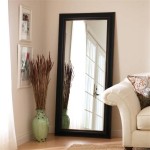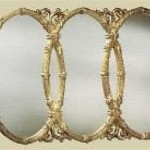How Big Should A Dresser Mirror Be?
Choosing the right dresser mirror involves considering several factors beyond mere aesthetics. The mirror's size should complement the dresser's dimensions while also serving its functional purpose: providing a clear and comprehensive reflection. This article explores the key elements to consider when determining the ideal size for a dresser mirror.
The dresser's width serves as the primary guide for choosing a mirror. A common guideline suggests the mirror should be slightly narrower than the dresser itself. This creates a visually balanced look, preventing the mirror from overwhelming the piece of furniture. For example, a 48-inch wide dresser might pair well with a mirror between 36 and 42 inches wide. This allows for a few inches of space on either side of the mirror, framing it nicely on the dresser's surface.
Proportionality extends beyond just width. The mirror's height also plays a crucial role in the overall aesthetic. A taller mirror can create an illusion of height in the room, making the space feel larger. However, an excessively tall mirror might look disproportionate if the dresser is relatively short. A good rule of thumb is to ensure the combined height of the dresser and mirror doesn't exceed the average eye level, typically around 60-66 inches. This prevents the mirror from dominating the wall space and maintains a balanced visual flow within the room.
The intended function of the mirror also influences its size. If the primary use is for quick checks of appearance, such as applying makeup or adjusting accessories, a smaller mirror might suffice. However, if the user intends to use the mirror for full-body checks before leaving the house, a taller, wider mirror is necessary. Considering the practical use ensures the mirror effectively serves its purpose.
The style of the dresser and mirror also impacts the ideal size relationship. A large, ornate mirror might complement a similarly styled dresser, even if the mirror's width slightly exceeds the general guidelines. Conversely, a minimalist dresser might benefit from a smaller, more understated mirror. Matching the mirror's scale and style to the dresser ensures a cohesive and aesthetically pleasing look.
The surrounding room's dimensions and décor also play a role. In a smaller room, a larger mirror can create an illusion of spaciousness by reflecting light and visually expanding the area. However, in an already cluttered room, a large mirror might exacerbate the sense of crowding. Consider the overall room aesthetic and the desired effect when selecting the mirror size.
Beyond standard rectangular mirrors, various shapes and styles exist, each with its own sizing considerations. Round or oval mirrors often appear smaller than rectangular mirrors of the same area due to their curved shape. Therefore, one might consider a slightly larger round or oval mirror compared to a rectangular one for the same dresser. Similarly, uniquely shaped mirrors, such as arched or geometric designs, require careful consideration of their proportions in relation to the dresser and the surrounding room.
Placement options also affect the perceived size of the mirror. A mirror hung above the dresser typically appears larger than the same mirror placed directly on the dresser surface. This is due to the added wall space surrounding the hanging mirror, creating a sense of expansiveness. Consider the chosen placement method when determining the ideal size.
Budget constraints can influence the size of the mirror. Larger mirrors generally cost more than smaller ones, particularly those with intricate frames or higher-quality glass. Balancing aesthetic desires with budget limitations is a practical consideration. Exploring various options within the desired budget range ensures finding a suitable mirror that meets both aesthetic and financial needs.
Ultimately, selecting the appropriate dresser mirror size involves a careful balance of aesthetic principles and practical considerations. By assessing the dresser's dimensions, the mirror's intended function, the surrounding room's décor, and budget constraints, individuals can choose a mirror that enhances both the dresser's appearance and the overall room's aesthetic appeal.
Exploring different mirror sizes and styles in person, either in a furniture store or by using online visualization tools, can provide a more concrete understanding of how different proportions will appear within the intended space. This allows for informed decision-making and ensures a satisfactory outcome.

How Big Should A Mirror Be Over Dresser In 2024 Grey Walls Interior Design

Steve Silver Highland Park 8 Drawer Rustic Ivory Dresser With Mirror 66 In Depth X 19 Width 79 Height Hp900drmrw The Home Depot

How To Pick The Right Size Mirror Antique Glass Ltd

Freslowe 6 Drawer Dresser And Mirror Ashley

How To Buy A Dresser With Mirror Living Spaces

Glam Up A Bedroom With Stylish Mirror Utr Decorating

Styling Our Bedroom Dresser Emily A Clark Decor Top

Riatto Dresser And Mirror

Steve Silver Bear Creek 9 Drawer Brown Dresser With Mirror 66 In Depth X 19 Width 78 Height Bc950drmr The Home Depot
:strip_icc()/114920061-cb47176aac644f4b9db1a653f23b498a.jpg?strip=all)
Easy Ways To Style A Dresser








